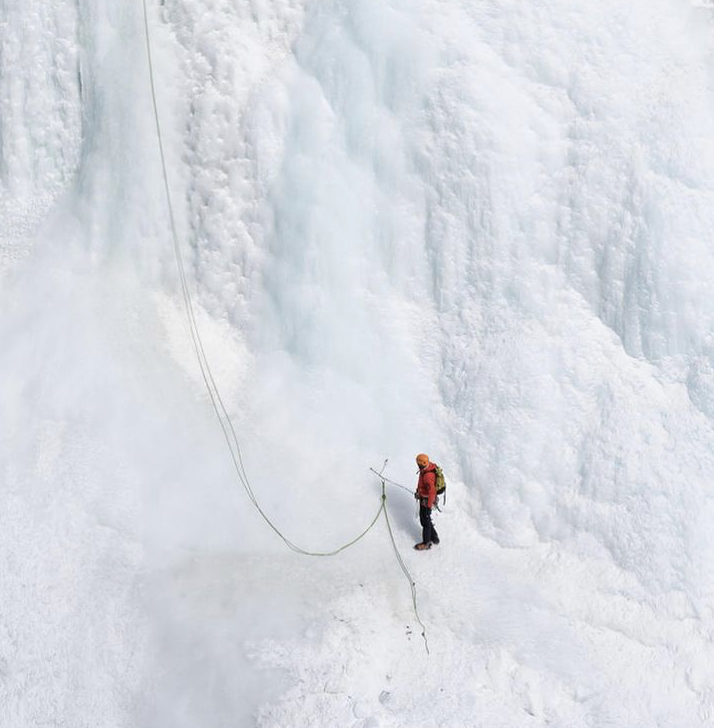
Alpine Tips
Close your rappel system with the “J loop”
Hopefully you know the importance of “closing the rope system” by always having the rope ends tied either to a harness or a stopper knot. Here's an extension of that idea for multi pitch rappels: the J loop.
image: @seanisaacguiding, instagram.com/p/CJHp9lSjKBk/
On a multi pitch rappel, the first person down can add an important safeguard to the system by tying the rope strands to the lower anchor. This is known by some as a “J loop”, because it makes a big letter “J."
To secure the rope, you have several options. A clove hitch on each strand is a good choice. Because the hitch falls apart when you remove it from the carabiner, you don't have to remember to untie yet another knot. An overhand on a bight / BHK tied in both strands is also effective, because if you forget to untie it, you have a closed loop.
Avoid tying a separate bight knot in each strand. Why? Because it's all too easy to forget to untie it, start pulling the rope, and then realize too late that you have a knot above you, big problem!
On a traversing rappel, you need to be VERY careful to always control the ends of the rope. Using J loop can help you avoid the potentially very serious problem shown in the diagram below.
IMAGE CREDIT: ANDY KIRKPATRICK
How does the J loop help reduce your risk?
Your partner can’t rappel off the ends of the rope, because it's tied to the anchor.
It makes it much less likely that the ends of the rope can swing or blow potentially out of your reach after your second arrives and goes off rappel, which could be a VERY serious problem if the rappel is traversing, overhanging, windy, or some combination of these.
It makes it much more likely that the first person down will remember to untie the stopper knots in the end of the rope. (After the J loop is tied, the stopper knots are no longer needed.)
In a traversing or overhanging rappel, the J loop helps guide your partner more smoothly into the anchor.
Finally, in the extremely unlikely catastrophe of the top rappel anchor failing, all may not be lost, because the rope is tied to the lower anchor.
Here's a nice diagram from Petzl showing the method. Note the BHK / overhand knot in both strands, and the end of purple, the pull rope, already threaded through the anchor master point. (The purple rope does not yet have a stopper knot in the end of it, that's the next step.)
image: https://www.petzl.com/US/en/Sport/Rappelling
For the first rappeller, the step-by-step procedure might look something like this. (This is one of several sequences that can work, not the only way.)
First person descending rigs for a standard rappel: using both strands of the rope, a stopper knot in each end of the rope, and an autoblock backup.
First rappeler arrives at the lower anchor. Clip tether to anchor. Keep your rappel device and auto block on the rope for now.
Feed 2-3 arm lengths of slack through your rappel device and auto block so your partner can get started.
Yell “off rappel”.
Optional but recommended: test pull. If your partner is not pre-rigged, do a test pull of the rope by pulling down a few meters on the pull strand to be sure it moves properly. Your partner above can answer this silent signal by pulling the rope back up. Be sure you have discussed this beforehand, so your partner up top knows what your test pull means, otherwise they might have a mild freak out. (If your partner is pre-rigged, you can’t do this step, because their auto block holds the rope in place.) If communication is difficult, note that the test pull can be a good non-verbal signal that you’re off rappel.
Tie a clove hitch in each strand and clip it with a locker onto some strong component of the anchor. Leave about 2 meters of slack to form the “J”. This slack allows you to do a test pull, and gives the second enough rope to descend.
Sweet, the rope is now secure in a J loop. Give yourself a high five. =^)
Untie the stopper knots in the end of each rope strand; you don't need them anymore.
Your smoking hot rappel device has now cooled off. Remove the rope from your rappel device and autoblock.
Pass the “pull” strand through the anchor, and tie a stopper knot in the pull end.
Wait for your partner to arrive. If for some reason they're not using an auto block backup, you can give them a firefighter belay. If they do have an auto block, there’s no need for the firefighter belay. That gives you a little break, whew! Use it to check the weather, grab a snack/water, get out your headlamp, scope the next rappel, read the topo, etc.
Once your partner arrives and is tethered to the lower anchor, untie the clove hitches.
Have a quick systems check: Both partners safely tethered, no twists or crosses in the rope, knot removed from the strand that’s going up.
Pull the rope slowly. Keep control of the end of the “up” strand until the last moment; don't let go of it and have it swing out of reach before you have to. (If the rope gets stuck as you're starting the pull, keeping control of the “up” strand greatly increases your options to solve the problem!)
When and how to belay a rappel
There are some circumstances where belaying a rappeller is a good choice. Learn two of those situations, and a quick way to set it up.
Note - This post discusses techniques and methods used in vertical rope work. If you do them wrong, you could die. Always practice vertical rope techniques under the supervision of a qualified instructor, and ideally in a progression: from flat ground, to staircase, to vertical close to the ground before you ever try them in a real climbing situation.
A belayed rappel is something many climbers think might be helpful only with a nervous beginner who needs the extra reassurance of a belay, or maybe an injured partner.
There’s another application - when you're rappelling into unfamiliar terrain with the location of the next anchors uncertain or nonexistent.
If there’s a reasonable chance that the person rappelling can’t locate the existing anchor (or a suitable place to build one) and needs to climb back up, it's going to be much easier to do so if they can be belayed by a separate rope strand. So, think of it as not really safeguarding the way down, but more to safeguard the rappeller climbing back up, should they need to do so.
Here's one way to set up a belayed rappel with two ropes.
(The same method applies with one rope. In the photos below, where you see the ropes tied together, imagine that’s the middle mark if you were using one rope.)
Here's the complete set up, ready to go. Yes it is a little confusing, so let's break it down step-by-step in the photos below.
Step 1:
Pass blue rope through the anchors, tie it to the green rope with a flat overhand bend.
Tie a stopper knot in blue, toss the blue rope.
Be sure that your green rope is stacked neatly, or in a rope bag or something similar.
Step 2:
Clip a locking carabiner, HMS preferred, to the master point.
Tie a butterfly in the blue rope, and clip it to this locker.
(Some people get freaked out about three-way loading on the blue carabiner. Black Diamond tested this, and it broke at at around 21 kN, which is the rated strength of the carabiner under a normal load. So, under the body weight of one person rappelling, it's not gonna be a problem.)
Step 3:
First person rappelling goes on rappel, single strand, blue rope. (Harness and third hand / autoblock not shown for clarity.)
Rigging an extended rappel (not shown) or using a Grigri or similar assisted braking belay device is a fine idea, because both of these can be easily converted to an ascending system if needed, as we cover here and here.
Step 4:
Take a second HMS carabiner (yellow), and clip it to the first one.
Tie a Munter hitch on this second locker.
Tie a bight knot in the end of the green rope.
Step 5:
With another locker, the rappeler clips the bight knot to their belay loop. Alternatively, you could skip this carabiner and bight knot, and tie in with a retraced figure 8. (Harness not shown for clarity.)
Schweeeeeet, now you're ready to go. First person down raps on blue rope, single strand. Person above feeds out green rope through the Munter hitch.
If the rapper has to go back up for any reason, they have a top rope belay for any part they can climb, with the option of ascending up the rappel rope (or even getting an assisted hoist) if it gets steeper. Depending on the terrain, this is probably faster and less strenuous than prusiking both strands, which they would probably have to do if they didn’t set it up like this.
When the first person reaches the ground (helpfully pulling down all of the green rope on their way) the top person cleans the carabiners and raps normally on two strands.
Here's a close-up of the rigging.
Note for belaying a beginner . . .
Anytime you're working with beginners who are just learning to rappel, it can be a good idea to not only have a belay, but also some kind of releasable system on the rappel rope. If they freeze on the rappel, get their shirt stuck in the device, whatever, you can release the system and get them to the ground.
Here's a modified way to set this up: Instead of fixing the rappel rope with a butterfly, fix it with a munter mule overhand (MMO), with at least 2-3 meters of slack behind it. If the rappeller gets hair or clothing stuck in their device, you can tension and hold the rappeller on the belay rope, then release and lower on the MMO. This creates some slack in the rappel rope, so the blockage can be removed.
In a more formal instructional situation, you're probably going to have a set up with a completely separate belay rope that's not tied to the rappel rope, which makes any mild rescue shenanigans you need to do quite a bit easier. But the main method shown here is a good compromise when on a real climb and needing to improvise a bit.












